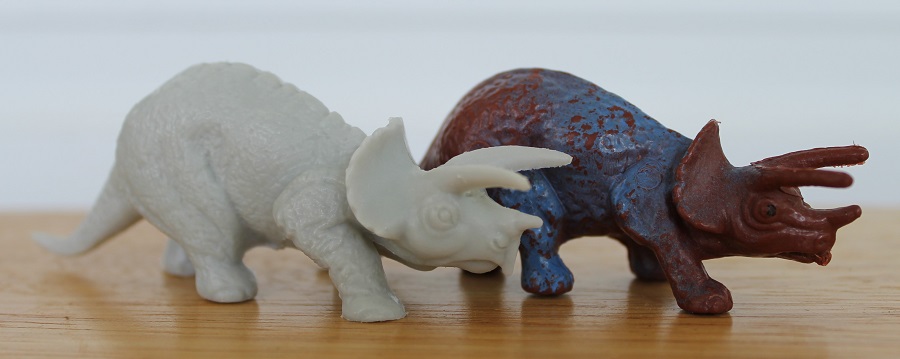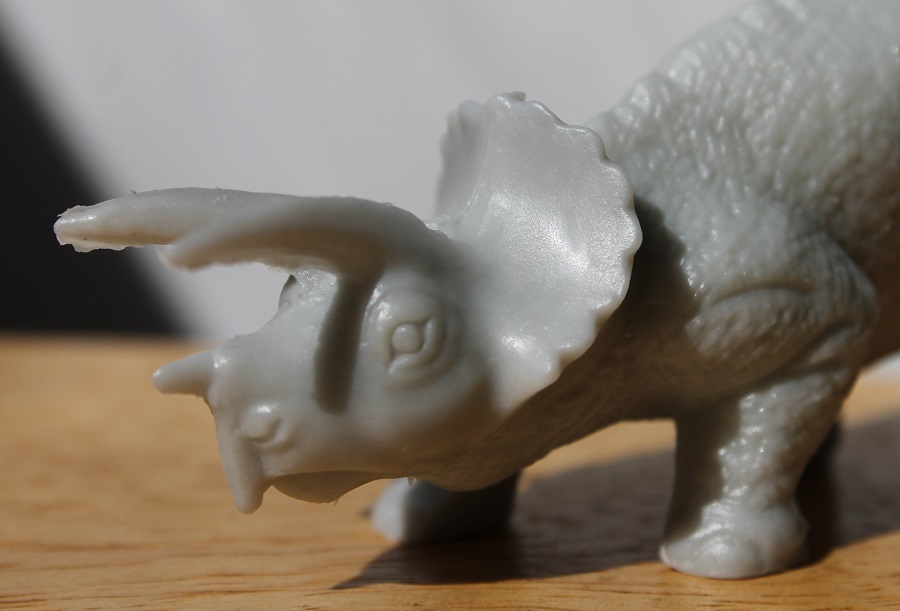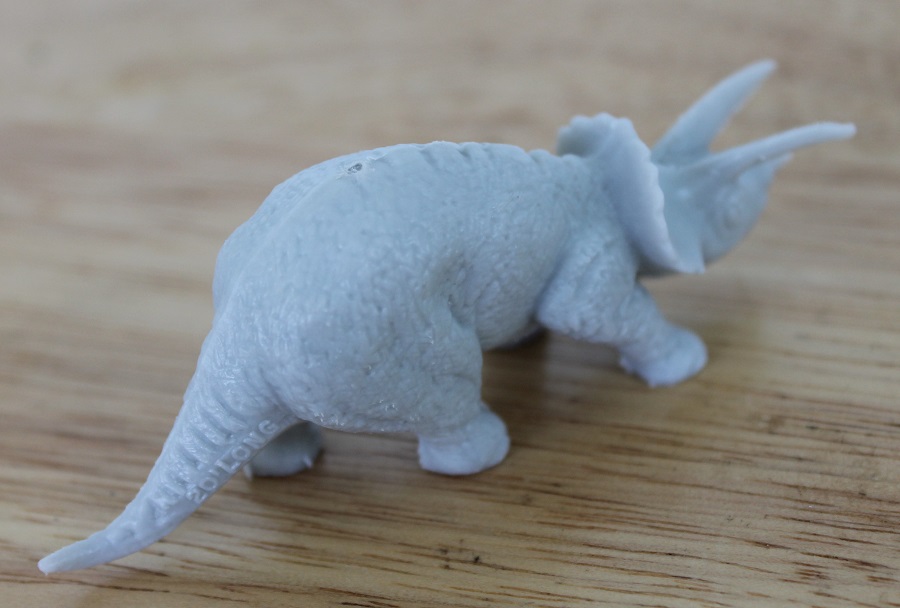No line of toy dinosaurs would be complete without a Triceratops and that’s a fact that has remained true since the beginning of dinosaur toy production with Marx in the 1950’s. Sure, many other elaborately horned dinosaurs have come onto the scene over the subsequent years but Triceratops is a classic and like Tyrannosaurus can never be dethroned. That it lived alongside T. rex and was among the largest and last of the ceratopsians only works in its favor.

The Marx Triceratops is part of the small mold group, PL-755 from 1955. Marx toys don’t conform to any set scale and the fact that this Triceratops is not much larger than the Cynognathus (which only reached 4’ in life) is a clear indication of this. The Marx Triceratops only measures 3.5” long and so does not scale as well as it should with the Marx T. rex. Like the previously reviewed Plateosaurus this dinosaur appears to be based on Rudolf Zallinger’s Age of Reptiles mural at the Yale Peabody Museum.

Like the Triceratops in Zallinger’s mural this toy has a low-slung head, splayed forelimbs, and erect hindlimbs that give it a hunch-backed appearance. It makes for a really uncomfortable and awkward looking animal that is reminiscent of a chameleon. Perhaps there’s something to this as the three-horned Jackson’s chameleon is superficially similar to Triceratops and often compared to it. Later reconstructions of Triceratops would straighten all of the limbs, like a rhinoceros, and this posture is reflected in the 1961 Marx Styracosaurus. Of course more modern reconstructions have the limbs splayed out again, though not as extreme as they used to be.

My daughter has a few old Marx knock-offs and having those in hand had for a long time put me off to Marx toys as something I should collect. I figured that they probably looked much the same and the knockoffs never impressed me. That was a mistake however, as the knockoffs are of a much more inferior quality by every conceivable metric. Having them both side-by-side now, the difference is significant.

The head sculpt on this Triceratops brings a lot of personality to an otherwise average toy. Actually, the frowning mouth, puffy cheeks, and rings around the eyes kind of remind me of some fancy goldfish varieties. This gives the toy an adorable yet confused and perhaps dim-witted appearance. The genus name is written on the left side of the tail and a length of 20’ is written on the right.

Marx only made two ceratopsians, this one and the Styracosaurus. It’s a shame that we never got a Monoclonius from them too. Before I set out to review these toys it never really dawned on me just how much inspiration these toys took from the science and art of their time. It’s fun to have these tiny three dimensional representations of the paleoart by such influencers as Burian, Knight, and Zallinger, and at this point I’ve now definitely caught the Marx collecting bug. The Marx Triceratops can be found on eBay for about $10-15 USD. As usual, Marx toys are cheaper in lots.

Disclaimer: links to Ebay and Amazon on the DinoToyBlog are affiliate links, so we make a small commission if you use them. Thanks for supporting us!



Soory for my own typos!
I believe Triceratops was misspelled on the first version and corrected on the seond (as well as some additioonal design changes implemented). If you have a 1955 type, could you vderify for me that Triceratops was misspeleed. I beliebed it was misspelled Tricerators… R instead of P.
This is the only one I have so I can’t compare them. That’s interesting though, I’ll have to look into it.
You’re right, there is a typo! I have one which appears to be an older mold version, and sure enough it says “TRICERATORS” on the left side of its tail! Hahaha – I never would have noticed!!
The irony of it is, MPC, which was infamous on doing Marx knockoffs, essentially copied their Triceratops off the Type I 1955 Marx version, including the misspelling! TRICERATORS!” Check out your MPC Triceratops.
…So, I did some checking again, and it looks like the revised 1959 figure, not the original 1955 (which it looks like Gwangi reviewed here), is actually the one with the typo. The revised figures appeared to have thinner, flimsier horns, and my own figures with flimsy horns are the ones with the typo.
Yep. That’s what I’m being told. Marx went from bad to worse on this one. The 1959 version is the one with the misspelling.
For what it’s worth, Triceratops is spelled correctly on mine.